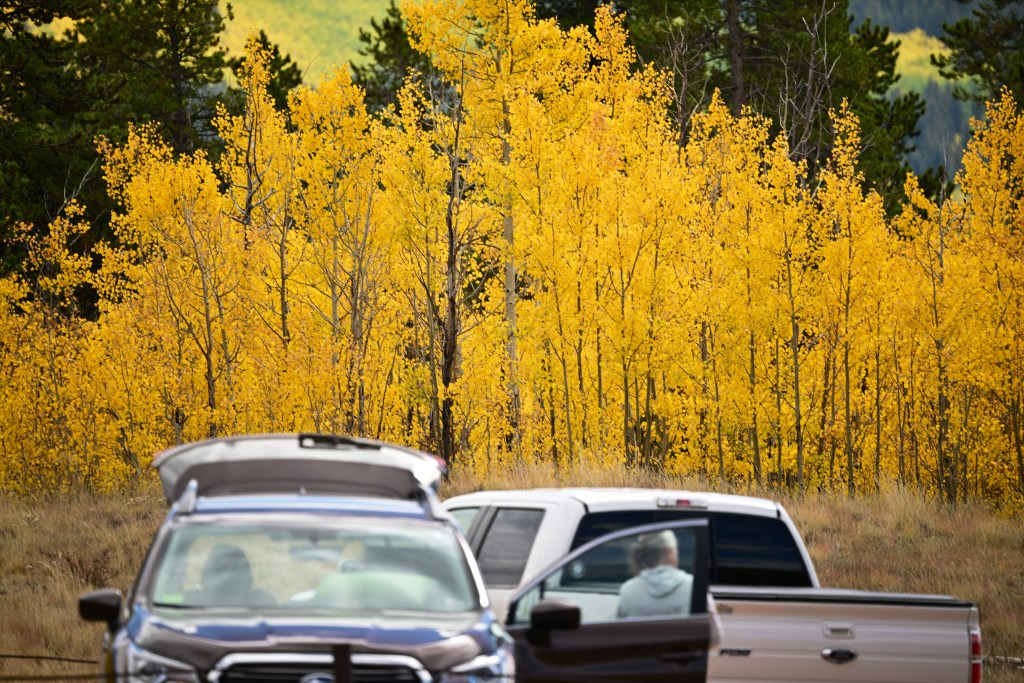Lifestyle
Colorado’s Early Fall Foliage Claims Debunked by Experts

Recent claims about early fall foliage in Colorado have raised eyebrows among experts. Reports from Summit County indicated that the vibrant colors associated with autumn had already begun to appear. However, Dan West, an entomologist with the Colorado State Forest Service, expressed skepticism regarding these assertions.
West, who routinely conducts aerial inspections of forests in Colorado, visited Summit and Eagle counties over the weekend to assess the situation firsthand. He found that the early color changes reported were not indicative of fall but rather symptoms of stress in the aspen trees due to ongoing drought conditions.
Understanding the True Cause of Color Change
“While there is a slight yellowing, it is primarily a stress response to drought,” West explained. He noted that many leaves exhibited signs of marginal necrosis, a condition where the edges of leaves turn brown due to inadequate moisture. This phenomenon occurs when trees lose water faster than they can absorb it, prompting them to shed parts of their leaves.
As West examined the trees, he remarked, “From a distance, it may appear that the trees are turning yellow, but closer inspection reveals that most of the foliage is more brown than yellow.” He anticipates that the actual fall color change will commence in two to three weeks, slightly earlier than the typical schedule, suggesting that the peak beauty may emerge around the third week of September.
Impact of Drought on Aspen Trees
Despite the concerns regarding early color changes, many aspen trees still display a healthy green hue. However, West reported observing stressed trees in various areas along the Interstate 70 corridor, including Breckenridge, Frisco, Silverthorne, and Vail Pass. “It’s pretty widespread along the I-70 corridor,” he noted, emphasizing that the reports of early autumn colors are more accurately reflections of poor tree health rather than the onset of the season.
As he walked through the forests, West was struck by the visible impact of drought stress on the aspens. “They start to shut down their processes a bit earlier,” he stated, indicating that some leaves are already falling due to these adverse conditions.
Looking ahead, West remains optimistic about the upcoming fall season. “There will still be a show,” he affirmed, pointing out that certain areas, particularly on the west side of Vail Pass, retain their lush green appearance. He predicted that while some stands may change color earlier than usual, others may exhibit more muted tones, with fewer deep oranges and vibrant reds than in previous years.
As the season progresses, residents and visitors alike can look forward to witnessing Colorado’s renowned fall foliage, albeit under the shadow of drought-related challenges.
-

 Technology5 months ago
Technology5 months agoDiscover the Top 10 Calorie Counting Apps of 2025
-

 Technology3 weeks ago
Technology3 weeks agoOpenAI to Implement Age Verification for ChatGPT by December 2025
-

 Health3 months ago
Health3 months agoBella Hadid Shares Health Update After Treatment for Lyme Disease
-

 Health3 months ago
Health3 months agoAnalysts Project Stronger Growth for Apple’s iPhone 17 Lineup
-

 Health3 months ago
Health3 months agoErin Bates Shares Recovery Update Following Sepsis Complications
-

 Technology5 months ago
Technology5 months agoDiscover How to Reverse Image Search Using ChatGPT Effortlessly
-

 Technology3 months ago
Technology3 months agoElectric Moto Influencer Surronster Arrested in Tijuana
-

 Technology2 months ago
Technology2 months agoDiscover 2025’s Top GPUs for Exceptional 4K Gaming Performance
-

 Technology5 months ago
Technology5 months agoMeta Initiates $60B AI Data Center Expansion, Starting in Ohio
-

 Technology5 months ago
Technology5 months agoRecovering a Suspended TikTok Account: A Step-by-Step Guide
-

 Health5 months ago
Health5 months agoTested: Rab Firewall Mountain Jacket Survives Harsh Conditions
-

 Lifestyle5 months ago
Lifestyle5 months agoBelton Family Reunites After Daughter Survives Hill Country Floods













